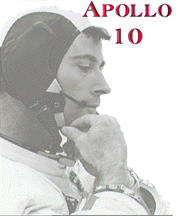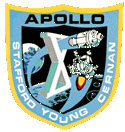
|

|
This page last updated |

|

|
This page last updated |

|
Apollo 10
AS-505
|
| 1 | 2 | 3 | 4 | 5 | 6 | 7 | 8 | 9 | 10 | 11 |
| 12 | 13 | 14 | 15 | 16 | 17 | 18 | 19 | 20 | 21 | 22 |
| 23 | 24 | 25 | 26 | 27 | 28 | 29 | 30 | 31 | 32 | Links |

Apollo 10 - last step to Moon - blasts off Sunday
Good luck Snoopy, Charlie Brown
NASA Manned Spacecraft Center Roundup - May 16, 1969Next Thursday two of the three Apollo 10 crewmen are scheduled to descend within eight nautical miles of the Moon's surface, the closest man has ever been to another celestial body.
This dress rehearsal for the first manned lunar landing in July, should blast off from Kennedy Space Center Sunday at 12:49 pm EDT.
The eight-day mission will mark the first use of a complete Apollo spacecraft in lunar orbit and the second manned flight for the lunar module.
Following closely the time line and trajectory to be flown on Apollo 11, Apollo 10 will include an eight-hour sequence of undocked LM activities during which the commander and LM pilot will skim the lunar surface twice and later rejoin the command/service module.
All aspects of Apollo 10 will duplicate conditions of the lunar landing mission as closely as possible: Sun angles at Apollo Site 2, out-and-back flight path to the Moon and the time line of mission events.
Apollo 10 is designed to provide additional operational experience for the crew, space vehicle and mission-report facilities during a simulated lunar landing.
Among the desired data points to be gained by the flight are LM systems operations at lunar distances and overall mission operational experience. The LM was successfully checked out in Earth orbit by Apollo 9 which included a rendezvous sequence simulating lunar orbit docking.
Space navigation experience around the Moon is another benefit to be gained from flying the practice mission. Closer study of the lunar gravitational effect through onboard landmark tracking will provide additional refinement of Manned Space Flight Network tracking techniques. Also, by updating the tracking and navigation methods used by Apollo 8 possible errors will be reduced.
Commander Thomas P. Stafford and LM Pilot Eugene A. Cernan will undock and make their descent inside Snoopy (LM call code), while CSM Pilot John W. Young manages the operations from Charlie Brown (CSM call code). The three men were recycled from the Apollo 7 backup crew.
Apollo 10 is scheduled for two Earth revolutions after launch, followed by translunar injection over Australia and three days to the Moon.
About an hour after TLI, the CSM will separate from the Saturn third stage, turn around and dock with the LM nested in the LM adapter. Spring-loaded LM holddowns will be released to eject the docked spacecraft from the adapter.
Later, leftover liquid propellant in the Saturn third stage, vented through the engine bell, will place the stage in a "slingshot" trajectory and into solar orbit.
During the translunar coast, Apollo 10 will be in a so-called passive thermal control mode in which the craft rotates slowly about one axis, stabilizing thermal response to solar heating. Four midcourse correction maneuvers are possible during the coast and will be planned in real time to adjust the trajectory.
Lunar orbit insertion burns, the first into a 60 x 170 nautical mile eliptical orbit and the second into a 60 mile circular orbit, will be made behind the Moon and out of contact with flight network stations.
The LM's two lunar surface sweeps will survey Site 2, one of the primary targets of the Apollo 11 landing.
Maximum separation between the LM and CSM will be about 350 miles. This will provide an extensive checkout of the LM rendezvous radar and a backup VHF ranging device being flown for the first time.
After LM-CSM redocking and crew transfer, the LM ascent engine will ignite, throwing the lunar vehicle into solar orbit.
The remaining lunar orbit time will be spent conducting lunar navigational tasks and photographing Apollo landing sites.
The transearth injection burn will be made behind the Moon after 61.5 hours in lunar orbit. During the 54-hour return trip the same passive thermal control "barbeque" technique will be applied and three midcourse corrections will be available to adjust the Earth entry corridor.
On Monday, May 26, Apollo 10 will enter the Earth's atmosphere at 400,000 feet, 191 hours, 51 minutes after launch, traveling 36,310 feet-per-second. CM touchdown will occur about 34 nautical miles east of Pago Pago, Tutuila, in American Samoa.
|
|
| 1 | 2 | 3 | 4 | 5 | 6 | 7 | 8 | 9 | 10 | 11 | 12 | 13 | 14 | 15 | 16 | |
| 17 | 18 | 19 | 20 | 21 | 22 | 23 | 24 | 25 | 26 | 27 | 28 | 29 | 30 | 31 | 32 | Links |
Home Biography Missions Appearances Bibliography Site Map Critique this site! Other Astros
John W. Young - American & International Hero Title Page
Page created by Dana Holland - webmaster @ johnwyoung.org
Dana's Page
This site is for informational and educational purposes only. It is NOT sanctioned by John Young, NASA, or Navarro College.